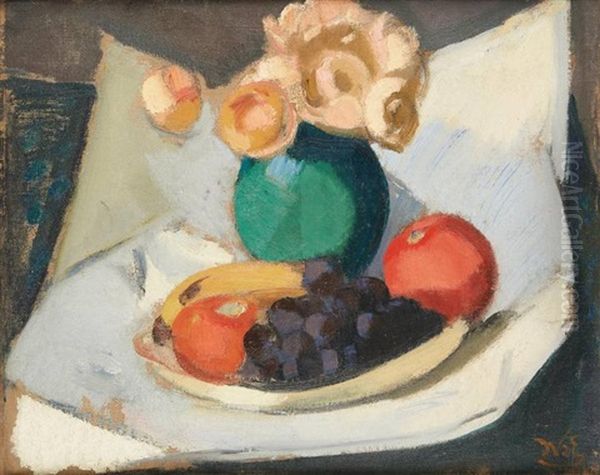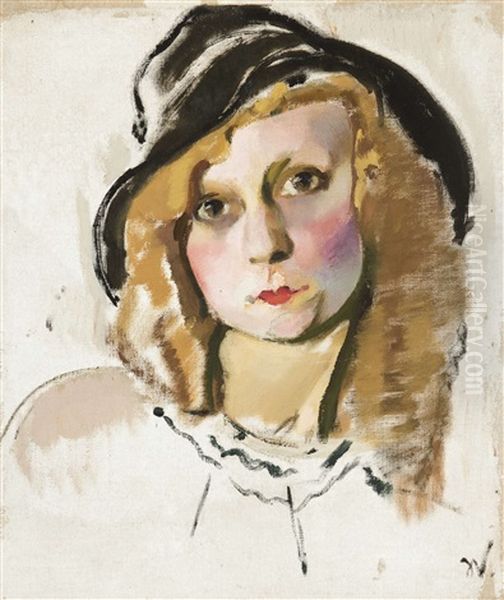Jean Van Den Eeckhoudt stands as a significant, yet sometimes overlooked, figure in the landscape of early 20th-century Belgian art. Born in 1875 and passing away in 1946, his life spanned a period of intense artistic innovation and upheaval across Europe. He is recognized primarily for his contributions to Fauvism within a Belgian context, developing a distinctive style characterized by vibrant colour and strong compositional structure. His journey through the art world connected him with key movements and influential figures, solidifying his place as one of the important painters emerging from Belgium during this era.
Early Life and Artistic Formation
Jean Van Den Eeckhoudt's artistic journey began in Brussels, the city of his birth in 1875. His initial immersion into the world of art was significantly shaped by his familial connections. He received early guidance from his uncle, the notable Belgian painter Isidore Verheyden. Verheyden, known for his landscapes and portraits, likely provided Van Den Eeckhoudt with a foundational understanding rooted in the Belgian realist and impressionist traditions prevalent at the time.
To further hone his skills, Van Den Eeckhoudt sought formal instruction. He took lessons in portraiture from Ernest Blanc-Garin, another established Belgian artist known for his portraits, genre scenes, and historical paintings. This early training under figures like Verheyden and Blanc-Garin equipped him with technical proficiency and exposed him to the prevailing artistic currents in Brussels towards the end of the 19th century, setting the stage for his own stylistic evolution.
Forging Friendships and Connections
The Brussels art scene at the turn of the century was a vibrant milieu, and Van Den Eeckhoudt quickly became integrated within it. A pivotal relationship formed in 1893 when he met the painter Henri Evenepoel. Evenepoel, though his life was tragically cut short, was a promising talent associated with Fauvism. Their meeting marked the beginning of a lifelong friendship, providing Van Den Eeckhoudt with a close confidant and fellow artist with whom he could share ideas and navigate the evolving art world. Such connections were crucial for young artists seeking encouragement and intellectual exchange.
Association with La Libre Esthétique

Van Den Eeckhoudt's engagement with the avant-garde movements of his time is clearly demonstrated by his involvement with "La Libre Esthétique" (The Free Aesthetic). This influential Brussels-based artistic circle was founded in 1894, essentially succeeding the progressive group "Les XX" (The Twenty). La Libre Esthétique aimed to promote modern art in Belgium, organizing annual exhibitions that showcased a wide range of Belgian and international artists working in Symbolism, Art Nouveau, Impressionism, and Post-Impressionism.
The group was established by prominent figures including the Symbolist painter Ferdinand Khnopff and the highly individualistic and pioneering Expressionist James Ensor. Van Den Eeckhoudt began exhibiting his work at the salons of La Libre Esthétique as early as 1895. His participation placed him firmly within the orbit of Belgium's most forward-thinking artists and exposed his work to a critical audience. This association was instrumental in establishing his reputation and connecting him with the broader currents of European modernism, including artists like Théo van Rysselberghe who were also associated with these progressive Belgian circles.
The Influence of France and the Rise of Fauvism
While rooted in the Belgian art scene, Van Den Eeckhoudt's artistic development was significantly impacted by his experiences in France. Beginning around 1905, he made regular trips to the central regions of France. He developed a particular fondness for the town of Roquebrune, located in the south of France near the Mediterranean coast. He spent many summers there and, significantly, resided there for much of the duration of the First World War (1914-1918).
This period, particularly the years spent in the south of France during the war, proved transformative for his art. It was during this time that Van Den Eeckhoudt developed a distinct Fauvist style. Fauvism, which had exploded onto the Paris art scene around 1905 led by artists like Henri Matisse and André Derain, was characterized by its radical use of non-naturalistic, intense colour and bold, expressive brushwork. The brilliant light and vibrant landscapes of the Mediterranean likely fueled Van Den Eeckhoudt's own exploration of saturated hues and simplified forms, pushing him away from his earlier influences towards a more modern, expressive idiom.
Mature Style: Colour, Form, and Influence
By the post-war period, Jean Van Den Eeckhoudt had forged a mature artistic style that synthesized various influences into a personal vision. His work became known for its emphasis on flat, decorative patterns and the use of highly saturated colours, often placed in striking juxtaposition. This approach shows a clear debt to the Fauvist movement, particularly in the liberation of colour from purely descriptive purposes.

Furthermore, his compositions often exhibit a strong sense of geometric structure and simplification of form. This aspect reveals the profound impact of Paul Cézanne, whose work was crucial for many modern artists seeking to move beyond Impressionism towards a more constructed and analytical approach to painting. Van Den Eeckhoudt absorbed Cézanne's lessons on building form through colour and structuring space, integrating these principles with the decorative flatness learned from the Nabis painters (like Pierre Bonnard or Édouard Vuillard) and the chromatic intensity of the Fauves.
His paintings often possess a distinct visual tension, created through the interplay of bold colour fields and defined shapes. He skillfully combined the lessons learned from French modernism – the decorative surfaces of the Nabis, the chromatic audacity of the Fauves, and the structural rigour of Cézanne – to create works that were both visually vibrant and compositionally solid. This synthesis marked his unique contribution to the broader European modernist dialogue.
Relationship with Henri Matisse
A significant aspect of Van Den Eeckhoudt's later career was his close relationship with the French master Henri Matisse. By 1920, Van Den Eeckhoudt was a well-established figure within the Belgian art world. It was around this time that he developed a deep and lasting friendship with Matisse, one of the towering figures of 20th-century art and a leader of the Fauvist movement.
This friendship was not merely personal; it had a profound impact on Van Den Eeckhoudt's subsequent artistic output. While he had already developed his Fauvist tendencies during the war years, the ongoing dialogue and connection with Matisse likely reinforced his commitment to colour and decorative composition. Matisse's own evolution, particularly his work from the Nice period onwards focusing on interiors, odalisques, and the interplay of pattern and light, may have resonated with Van Den Eeckhoudt's own explorations. This connection underscores Van Den Eeckhoudt's engagement with the highest levels of contemporary French painting.
Key Works and Themes
Several specific works help illustrate the characteristics of Jean Van Den Eeckhoudt's art. Le Chapeau Mexicain (The Mexican Hat) is cited as one of his most famous paintings and is held in the collection of the Royal Museums of Fine Arts of Belgium in Brussels. While details of this specific work require viewing, its title suggests a potentially exotic subject rendered in his characteristic colourful and decorative style.
Fleurs et fruits (Flowers and Fruit), dated 1919, is particularly noted as embodying his transition and mature style shortly after the First World War. This work reportedly showcases the influence of the Nabis, Matisse, and Cézanne, likely featuring flattened planes of strong colour, simplified forms for the flowers and fruit, and perhaps the structured brushwork reminiscent of Cézanne, all hallmarks of his Fauvist period.
Other mentioned works, such as La Roquebrune sous la neige (Roquebrune under Snow) from 1934 and L'Angélique à la chapelle Saint Roch (Angelica at the Saint Roch Chapel) from 1924, point to his continued engagement with landscape and potentially figurative themes later in his career. The Roquebrune painting indicates his enduring connection to the French town that was so pivotal to his artistic development, even depicting it in the less common condition of being snow-covered, which would have offered different chromatic possibilities. His works often captured the intense light and colour of the Mediterranean but also explored other atmospheric conditions. Still lifes and landscapes appear to have been central themes in his oeuvre.
Context within Belgian Art
Jean Van Den Eeckhoudt occupies an important position within the rich tapestry of Belgian art at the turn of the 20th century. He emerged alongside contemporaries who were shaping various modern movements within the country. His association with La Libre Esthétique placed him alongside figures like James Ensor and Ferdinand Khnopff, although his stylistic path diverged significantly from theirs.
His embrace of Fauvism aligns him more closely with artists like Rik Wouters, another key Belgian Fauvist known for his vibrant depictions of domestic life and landscapes, although Wouters' career was also tragically short. Van Den Eeckhoudt's work, with its emphasis on colour and light, provides a contrast to the darker, more socially-oriented themes explored by Belgian Expressionists such as Constant Permeke or Gustave De Smet, who rose to prominence slightly later. His enduring connection to French modernism, particularly Fauvism and the influence of Matisse and Cézanne, distinguishes his contribution within the national context. He effectively acted as a conduit, interpreting these major European trends through his own sensibility.
Distinction from Gerbrand van den Eeckhout
It is critically important to distinguish Jean Van Den Eeckhoudt (1875-1946), the Belgian modernist painter, from his near-namesake, Gerbrand van den Eeckhout (1621-1674). Gerbrand was a prominent painter of the Dutch Golden Age, working over two centuries earlier. Born in Amsterdam, Gerbrand van den Eeckhout was one of the most talented and favoured pupils of the great master Rembrandt van Rijn.
Gerbrand worked in a Baroque style, excelling in historical and biblical scenes, genre paintings, and portraits. His style, particularly in his religious works, often closely mirrored that of Rembrandt, leading to occasional misattributions. He was a respected figure in 17th-century Amsterdam's art scene. There is absolutely no connection between Gerbrand van den Eeckhout, the Dutch Baroque painter and student of Rembrandt, and Jean Van Den Eeckhoudt, the 20th-century Belgian Fauvist, other than the similarity in their names. This distinction is essential for accurate art historical understanding.
Later Years and Legacy
Jean Van Den Eeckhoudt continued to paint throughout his life. He passed away in 1946 in the small Belgian town of Bourgeois (now part of Rixensart). By the time of his death, he had secured his reputation as a significant contributor to Belgian modern art. His work had been exhibited regularly, and he was recognized for his unique synthesis of French modernist influences within a Belgian context.
His legacy endures through his artworks, which are held in the collections of major Belgian institutions, including the Royal Museums of Fine Arts of Belgium, as well as other European museums and private collections. He is remembered as one of the foremost Belgian painters associated with Fauvism, admired for his bold use of colour, his decorative compositions, and his ability to capture the vibrancy of light and landscape. While perhaps not as internationally famous as his friend Matisse or compatriots like Ensor or Magritte, Jean Van Den Eeckhoudt remains a key figure for understanding the development of modern painting in Belgium during the first half of the 20th century. His work continues to be appreciated for its visual intensity and its skillful negotiation of colour and form.